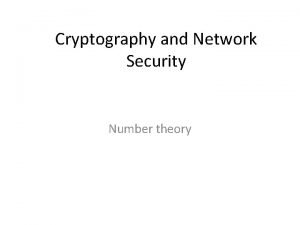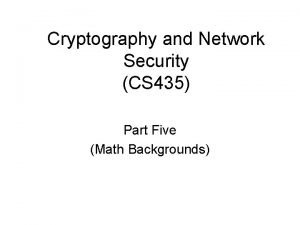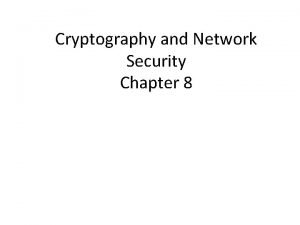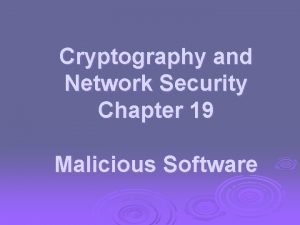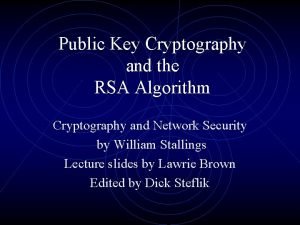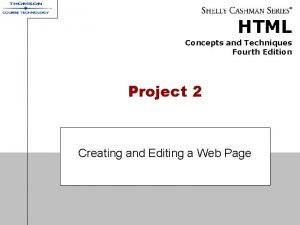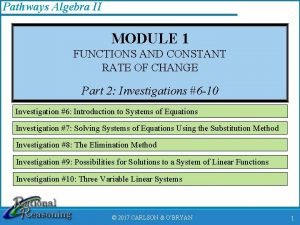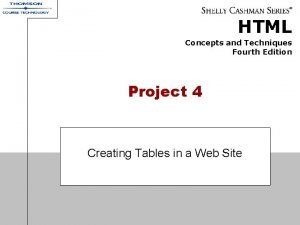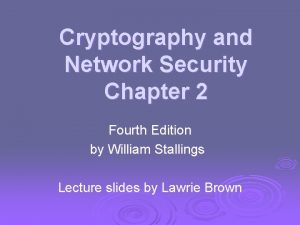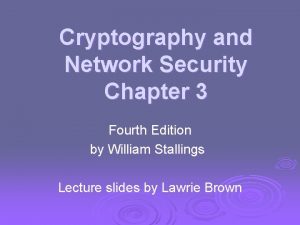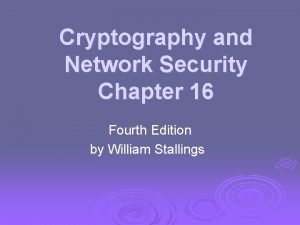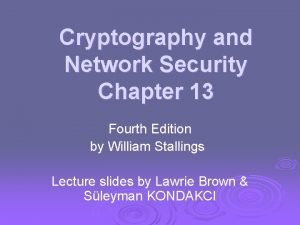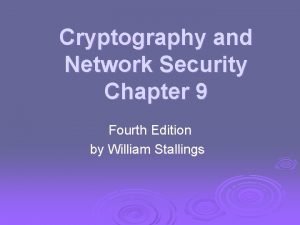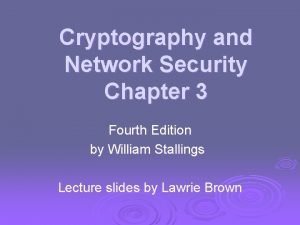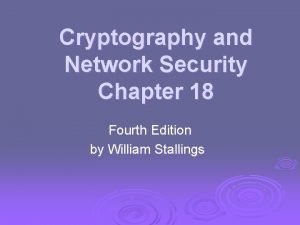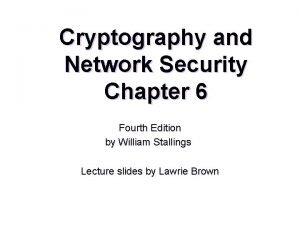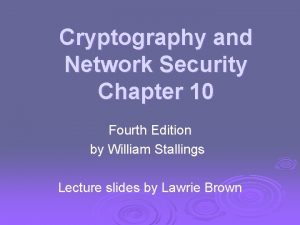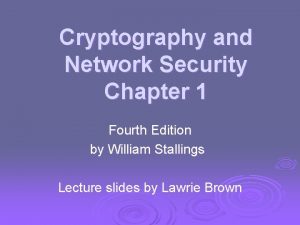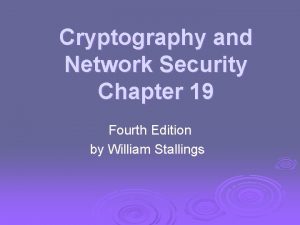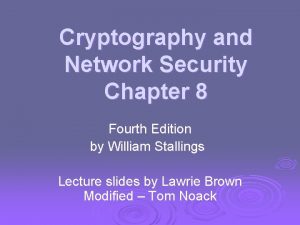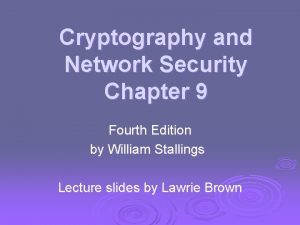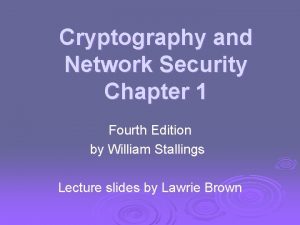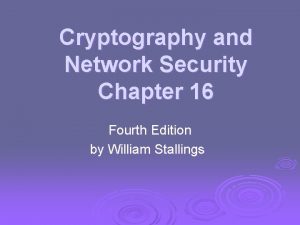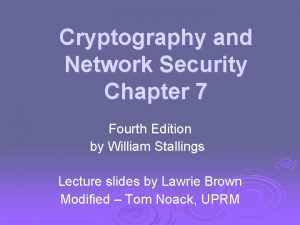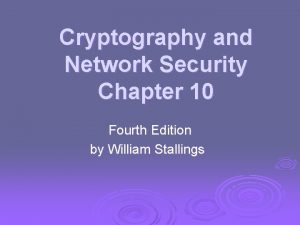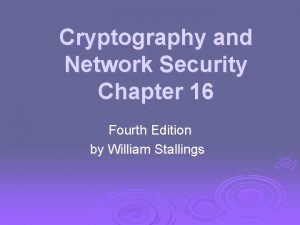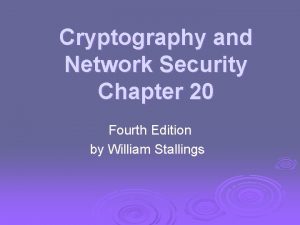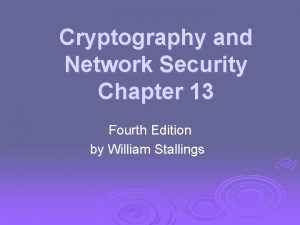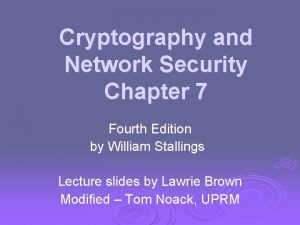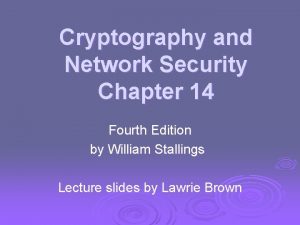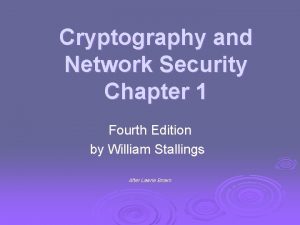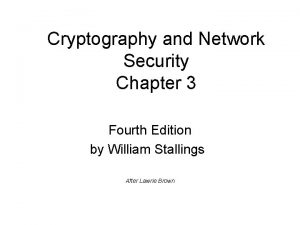Cryptography and Network Security Chapter 20 Fourth Edition






























- Slides: 30

Cryptography and Network Security Chapter 20 Fourth Edition by William Stallings

Chapter 20 – Firewalls The function of a strong position is to make the forces holding it practically unassailable —On War, Carl Von Clausewitz

Introduction seen evolution of information systems Ø now everyone want to be on the Internet Ø and to interconnect networks Ø has persistent security concerns Ø l can’t easily secure every system in org typically use a Firewall Ø to provide perimeter defence Ø as part of comprehensive security strategy Ø

What is a Firewall? Ø a choke point of control and monitoring Ø interconnects networks with differing trust Ø imposes restrictions on network services l only authorized traffic is allowed Ø auditing and controlling access l can implement alarms for abnormal behavior Ø provide NAT & usage monitoring Ø implement VPNs using IPSec Ø must be immune to penetration

Firewall Limitations Ø cannot protect from attacks bypassing it l eg sneaker net, utility modems, trusted organisations, trusted services (eg SSL/SSH) Ø cannot protect against internal threats l eg disgruntled or colluding employees Ø cannot protect against transfer of all virus infected programs or files l because of huge range of O/S & file types

Firewalls – Packet Filters Ø simplest, fastest firewall component Ø foundation of any firewall system Ø examine each IP packet (no context) and permit or deny according to rules Ø hence restrict access to services (ports) Ø possible default policies l l that not expressly permitted is prohibited that not expressly prohibited is permitted

Firewalls – Packet Filters

Firewalls – Packet Filters

Attacks on Packet Filters Ø IP address spoofing l l fake source address to be trusted add filters on router to block Ø source routing attacks l l attacker sets a route other than default block source routed packets Ø tiny fragment attacks l l split header info over several tiny packets either discard or reassemble before check

Firewalls – Stateful Packet Filters Ø traditional packet filters do not examine higher layer context l ie matching return packets with outgoing flow Ø stateful packet filters address this need Ø they examine each IP packet in context l l keep track of client-server sessions check each packet validly belongs to one Ø hence are better able to detect bogus packets out of context

Firewalls - Application Level Gateway (or Proxy) Ø have application specific gateway / proxy Ø has full access to protocol l l user requests service from proxy validates request as legal then actions request and returns result to user can log / audit traffic at application level Ø need separate proxies for each service l l some services naturally support proxying others are more problematic

Firewalls - Application Level Gateway (or Proxy)

Firewalls - Circuit Level Gateway Ø relays two TCP connections Ø imposes security by limiting which such connections are allowed Ø once created usually relays traffic without examining contents Ø typically used when trust internal users by allowing general outbound connections Ø SOCKS is commonly used

Firewalls - Circuit Level Gateway

Bastion Host highly secure host system Ø runs circuit / application level gateways Ø or provides externally accessible services Ø potentially exposed to "hostile" elements Ø hence is secured to withstand this Ø l l hardened O/S, essential services, extra auth proxies small, secure, independent, non-privileged may support 2 or more net connections Ø may be trusted to enforce policy of trusted separation between these net connections Ø

Firewall Configurations

Firewall Configurations

Firewall Configurations

Access Control Ø given system has identified a user Ø determine what resources they can access Ø general model is that of access matrix with l l l subject - active entity (user, process) object - passive entity (file or resource) access right – way object can be accessed Ø can decompose by l l columns as access control lists rows as capability tickets

Access Control Matrix

Trusted Computer Systems information security is increasingly important Ø have varying degrees of sensitivity of information Ø l cf military info classifications: confidential, secret etc subjects (people or programs) have varying rights of access to objects (information) Ø known as multilevel security Ø l l Ø subjects have maximum & current security level objects have a fixed security level classification want to consider ways of increasing confidence in systems to enforce these rights

Bell La. Padula (BLP) Model one of the most famous security models Ø implemented as mandatory policies on system Ø has two key policies: Ø no read up (simple security property) Ø l Ø a subject can only read/write an object if the current security level of the subject dominates (>=) the classification of the object no write down (*-property) l a subject can only append/write to an object if the current security level of the subject is dominated by (<=) the classification of the object

Reference Monitor

Evaluated Computer Systems Ø governments can evaluate IT systems Ø against a range of standards: l TCSEC, IPSEC and now Common Criteria Ø define a number of “levels” of evaluation with increasingly stringent checking Ø have published lists of evaluated products l l though aimed at government/defense use can be useful in industry also

Common Criteria international initiative specifying security requirements & defining evaluation criteria Ø incorporates earlier standards Ø l Ø eg CSEC, ITSEC, CTCPEC (Canadian), Federal (US) specifies standards for l l l evaluation criteria methodology for application of criteria administrative procedures for evaluation, certification and accreditation schemes

Common Criteria Ø defines set of security requirements Ø have a Target Of Evaluation (TOE) Ø requirements fall in two categories l l functional assurance Ø both organised in classes of families & components

Common Criteria Requirements Ø Functional Requirements l security audit, crypto support, communications, user data protection, identification & authentication, security management, privacy, protection of trusted security functions, resource utilization, TOE access, trusted path Ø Assurance Requirements l configuration management, delivery & operation, development, guidance documents, life cycle support, tests, vulnerability assessment, assurance maintenance

Common Criteria

Common Criteria

Summary Ø have considered: l l l firewalls types of firewalls configurations access control trusted systems common criteria
 Cryptography and network security 6th edition
Cryptography and network security 6th edition Cryptography and network security 6th edition pdf
Cryptography and network security 6th edition pdf Cryptography and network security 4th edition
Cryptography and network security 4th edition Cryptography and network security pearson
Cryptography and network security pearson Wireless security in cryptography and network security
Wireless security in cryptography and network security Introduction to cryptography and network security
Introduction to cryptography and network security Number theory in cryptography and network security
Number theory in cryptography and network security Firewall in cryptography and network security
Firewall in cryptography and network security Authentication in cryptography and network security
Authentication in cryptography and network security Intruders in cryptography and network security
Intruders in cryptography and network security Primitive root
Primitive root Source
Source Euler's theorem in cryptography and network security
Euler's theorem in cryptography and network security Finite fields in cryptography and network security
Finite fields in cryptography and network security Dsa in network security
Dsa in network security Gcd(1970,1066)
Gcd(1970,1066) Pgp in cryptography and network security
Pgp in cryptography and network security Euler's theorem in cryptography and network security
Euler's theorem in cryptography and network security Malicious software in cryptography and network security
Malicious software in cryptography and network security Introduction to cryptography and network security
Introduction to cryptography and network security Rsa algorithm in cryptography and network security
Rsa algorithm in cryptography and network security Introduction to cryptography and network security
Introduction to cryptography and network security Expert systems: principles and programming, fourth edition
Expert systems: principles and programming, fourth edition Network security essentials 5th edition
Network security essentials 5th edition Network security essentials 5th edition
Network security essentials 5th edition Project 2 fourth edition
Project 2 fourth edition Pathways algebra 2 answer key
Pathways algebra 2 answer key Ethics in information technology fourth edition
Ethics in information technology fourth edition Ethics in information technology fourth edition
Ethics in information technology fourth edition Vertical line html
Vertical line html A computer programming team has 13 members
A computer programming team has 13 members












